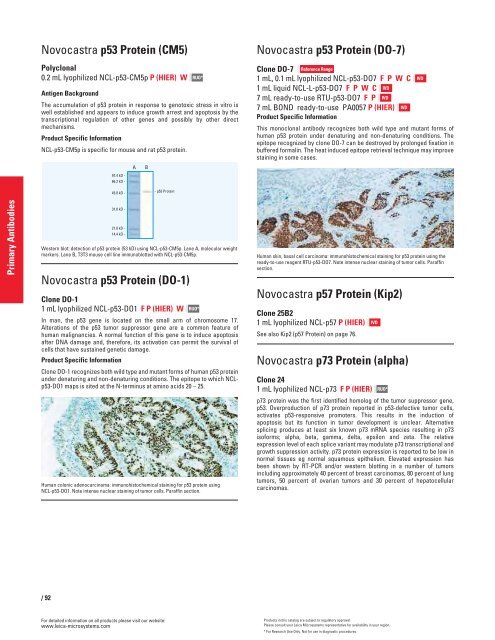QF0159 Marketing Release Record
QF0159 Marketing Release Record
QF0159 Marketing Release Record
Create successful ePaper yourself
Turn your PDF publications into a flip-book with our unique Google optimized e-Paper software.
Primary Antibodies<br />
Novocastra p53 Protein (CM5)<br />
Polyclonal<br />
0.2 mL lyophilized NCL-p53-CM5p P (HIER) W<br />
Antigen Background<br />
The accumulation of p53 protein in response to genotoxic stress in vitro is<br />
well established and appears to induce growth arrest and apoptosis by the<br />
transcriptional regulation of other genes and possibly by other direct<br />
mechanisms.<br />
Product Specific Information<br />
NCL-p53-CM5p is specific for mouse and rat p53 protein.<br />
Western blot: detection of p53 protein (53 kD) using NCL-p53-CM5p. Lane A, molecular weight<br />
markers. Lane B, T3T3 mouse cell line immunoblotted with NCL-p53-CM5p.<br />
Novocastra p53 Protein (DO-1)<br />
Clone DO-1<br />
1 mL lyophilized NCL-p53-DO1 F P (HIER) W<br />
In man, the p53 gene is located on the small arm of chromosome 17.<br />
Alterations of the p53 tumor suppressor gene are a common feature of<br />
human malignancies. A normal function of this gene is to induce apoptosis<br />
after DNA damage and, therefore, its activation can permit the survival of<br />
cells that have sustained genetic damage.<br />
Product Specific Information<br />
Clone DO-1 recognizes both wild type and mutant forms of human p53 protein<br />
under denaturing and non-denaturing conditions. The epitope to which NCLp53-DO1<br />
maps is sited at the N-terminus at amino acids 20 – 25.<br />
Human colonic adenocarcinoma: immunohistochemical staining for p53 protein using<br />
NCL-p53-DO1. Note intense nuclear staining of tumor cells. Paraffin section.<br />
/92<br />
For detailed information on all products please visit our website:<br />
www.leica-microsystems.com<br />
RUO*<br />
RUO*<br />
Novocastra p53 Protein (DO-7)<br />
Clone DO-7 Reference Range<br />
1 mL, 0.1 mL lyophilized NCL-p53-DO7 FPWC<br />
1 mL liquid NCL-L-p53-DO7 FPWC IVD<br />
7 mL ready-to-use RTU-p53-DO7 FP IVD<br />
7 mL BOND ready-to-use PA0057 P (HIER)<br />
Product Specific Information<br />
IVD<br />
This monoclonal antibody recognizes both wild type and mutant forms of<br />
human p53 protein under denaturing and non-denaturing conditions. The<br />
epitope recognized by clone DO-7 can be destroyed by prolonged fixation in<br />
buffered formalin. The heat induced epitope retrieval technique may improve<br />
staining in some cases.<br />
Human skin, basal cell carcinoma: immunohistochemical staining for p53 protein using the<br />
ready-to-use reagent RTU-p53-DO7. Note intense nuclear staining of tumor cells. Paraffin<br />
section.<br />
Novocastra p57 Protein (Kip2)<br />
Clone 25B2<br />
1 mL lyophilized NCL-p57 P (HIER)<br />
See also Kip2 (p57 Protein) on page 76.<br />
Novocastra p73 Protein (alpha)<br />
Clone 24<br />
1 mL lyophilized NCL-p73 F P (HIER)<br />
p73 protein was the first identified homolog of the tumor suppressor gene,<br />
p53. Overproduction of p73 protein reported in p53-defective tumor cells,<br />
activates p53-responsive promoters. This results in the induction of<br />
apoptosis but its function in tumor development is unclear. Alternative<br />
splicing produces at least six known p73 mRNA species resulting in p73<br />
isoforms; alpha, beta, gamma, delta, epsilon and zeta. The relative<br />
expression level of each splice variant may modulate p73 transcriptional and<br />
growth suppression activity. p73 protein expression is reported to be low in<br />
normal tissues eg normal squamous epithelium. Elevated expression has<br />
been shown by RT-PCR and/or western blotting in a number of tumors<br />
including approximately 40 percent of breast carcinomas, 80 percent of lung<br />
tumors, 50 percent of ovarian tumors and 30 percent of hepatocellular<br />
carcinomas.<br />
IVD<br />
RUO*<br />
Products in this catalog are subject to regulatory approval.<br />
Please consult your Leica Microsystems representative for availability in your region.<br />
* For Research Use Only. Not for use in diagnostic procedures.<br />
IVD
















